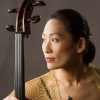
New and Old
Yeesun Kim
This summer I had two very different experiences performing contemporary pieces. The first piece, as it turned out, had several performances spread over two months. Two concerts included working with the composer prior to the concert. The second piece was set up to be only performed once, without the composer’s presence and with only two days of rehearsing. Both pieces were quite difficult in their own ways. The first piece called for virtuosity, stamina and the ability to clearly outline the structure and narrative in order to hold the piece together. The second piece was almost the exact opposite. Short and obsessively detailed in its use of sound effects, it abounded in the use of extended techniques. It employed extremely soft dynamics and seemed to purposefully obscure perceptible structure in order to create a sense of a boundless soundscape. In preparation for these concerts, I came to realize that my sense of what is new and old was called into question at various levels.
By the third performance of the first piece, many aspects of the piece felt familiar. The piece took root in my memory banks and the piece was allowed to take a life of its own on stage. I felt myself breathing with the rhythm of the story and delivering the content with involved objectivity. The composer’s way of working changed throughout as well. At first it was more about getting the general character of the piece, then he became increasingly detailed in describing colors, articulations, dynamic shadings, timings and specific shaping of phrases. This latter process helps a performer to define a particular composer’s language. It is very exciting how bringing out this character with confidence creates a sensation that will be NEW and UNIQUE for the listener.
With the second piece, with all its detailed markings and commentaries, my mind was so filled with directions that it took me a while to even notice that the piece only lasted about fifteen minutes. With two days of rehearsal, I had to figure out quickly how to make the piece sound convincing, how to make the piece sound OLD and FAMILIAR. Obviously I had to aim for the big picture. As I moved through the series of unique soundscapes, I tried to imagine, in an aural sense, what linked them together and describe to myself the process of transformation. Through this sense of linkage and belonging I felt better able to generate familiarity and continuous momentum with the piece that started to grow within me. I really look forward to working and performing the piece again and maybe I will be lucky to work with the composer which no doubt will add an extra dimension to the image I have already formed myself.
Each performance situation comes with diverse challenges. But, working with each circumstance, I think we can always find some truly meaningful ways of connecting with the pieces we present. There are so many masterpieces in the classical music repertoire. We play them and they give us so much to feel and think about. I hope that we can be inspired by what we find in recent pieces and both rethink the old and familiarize the new. Old pieces have survived the scrutiny of generations. With sufficient creativity and insight from performers, new pieces can live for so many years to come and give us sensations both old and new.
Subjects: Chamber Music, Repertoire
Tags: ability, articulations, cello, cellobello, challenges, character, composers, confidence, creativity, dynamics, familiar, Kim, music, rehearsals, Rhythm, soundscapes, structure, unique, virtuosity, Yeesun
